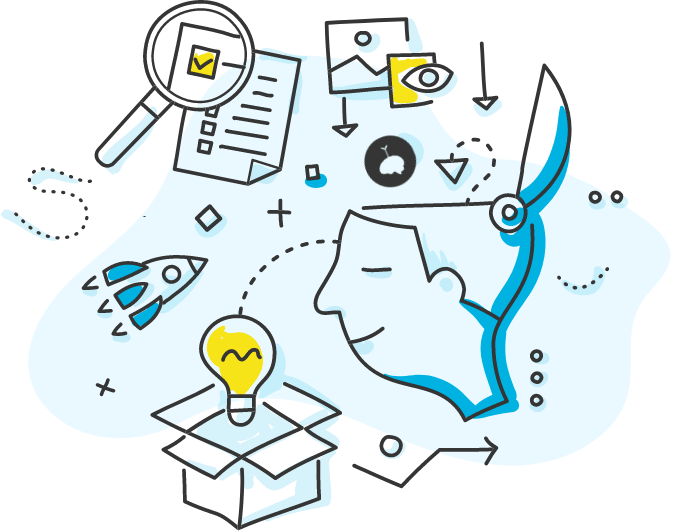Estimated Reading Time: 4 minutes, 22s. It’s pretty skimmable, though!

A 2012 report from the McKinsey Global Institute found the average person spends a whopping 28% of their workday managing emails. In addition, other studies have discovered:
- We check our email an average of 11 times an hour.1)
- 84% of people keep email open in the background as they work.2)
- 64% of people use email notifications to alert them of new messages.3)
- 70% of all emails received are opened within the first 6 seconds of receipt.4)
- After opening a message, it takes you, on average, 64 seconds to resume the task you were working on before being interrupted.5)
These stats are incredible—and while email is ubiquitous, it’s not without its costs. As attention researcher Gloria Mark discovered, the more time we spend on email in a given day, the lower we perceive our productivity to be, and the more stressed we feel. Email also significantly contributes to feelings of cognitive overload. According to Gloria, a number of factors are responsible for this, including:
- A lack of clarity in email requests;
- The work being demanded in emails;
- Poor email management strategies;
- Feelings of a loss of control;
- Problems keeping track of email threads;
- Interruptions due to email;
- Social pressure to quickly reply (especially when the sender is higher up in the organizational hierarchy).
On top of this, Gloria says “email generally imposes more costs on the receipting than the sender.”
I’ve bolded the third point because it’s the one over which we have the most control. We can mitigate a lot of email-induced stress by managing it in a more effective and deliberate way.
According to Gloria’s research, there are three main ways we can manage our email:
- By checking whenever we receive a new notification;
- By checking whenever we choose to, without the aid of external notifications (dealing with multiple emails at once in this way is called ”batching”);
- By employing a mix of both of these methods.
Which one is most effective?
To find out, Gloria and her team of researchers strapped a heart rate monitor onto 40 employees at Microsoft, and installed a program on their computer to log email activity. The participants also reported their daily productivity through a survey each evening. Gloria and her team looked at each participants’ heart rate variability—”a well-validated indicator of mental stress that is used extensively in research and clinical studies.” After collecting this data, the team examined the stress and productivity levels of the employees paired with their email management strategy. They found that 30.8% of employees checked their email throughout the day after receiving notifications, 41% batched their email and checked for new messages by choice, and 28.2% adopted a mixed strategy.
Some of their discoveries were fascinating:
- Batching email didn’t make employees any more productive;
- Those who batched email experienced just as much stress as those who checked for messages throughout the day;
- The more time participants spent on email, the lower they assessed their productivity to be;
- The more time people spent on email, the higher their level of stress.
A few other curious findings: participants spent a whopping 1.5 hours on email each day; they checked for new messages 77 times a day; and the more autonomy employees had in their jobs, the less frequently they checked for new messages.
These findings—particularly the ones about email batching—are huge, and Gloria and her team agree. “Many claims in the popular media tout that batching email should lead people to be more productive and feel less stress. Our study found some support for these claims for productivity but only with high email use.” (Emphasis mine.)
There are a few big lessons to take away:
- It doesn’t matter how you prefer to check your email—but you should consider the toll checking for messages has on your productivity. It takes an average of 64 seconds to get back on track after opening a new email.
- If you’re going to batch, batch less frequently. While this study suggests batching doesn’t work when you do it frequently throughout the day, I’d still argue that batching is a powerful strategy when done infrequently. For example, I check for new messages just once a day, and have found I spend a lot less time and attention on email this way. The research backs this up: while checking your email once a day may not reduce stress, it has been shown to save a significant amount of time.6)
- Don’t listen exclusively to the “experts.” Here’s the thing about personal productivity advice: it’s personal! What works for one person may not work for you—everyone is wired differently, and so is their work. Like with all productivity advice, try stuff out, keep doing what works, and leave the rest.
Managing email is an essential part of doing knowledge work for a living—but by checking it less and managing it more deliberately, we can become less stressed, and save valuable time and attention for much more important things.
Source: Focused, Aroused, but so Distractible: Temporal Perspectives on Multitasking and Communications (study ↩
Source: “You’ve Got E-Mail!” … Shall I Deal With It Now? Electronic Mail From the Recipient’s Perspective (study ↩
Source: “You’ve Got E-Mail!” … Shall I Deal With It Now? Electronic Mail From the Recipient’s Perspective (study ↩
Source: Understanding email interaction increases organizational productivity (study ↩
Source: Understanding email interaction increases organizational productivity (study ↩
Source: How to manage your inbox: Is a once a day strategy best? (study ↩




